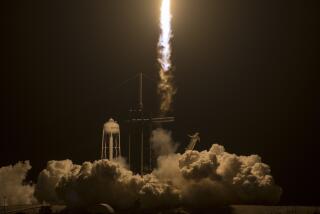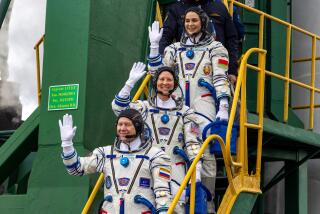Soviets Lose Some Contact With Mars Probe
- Share via
Scientists in the Soviet Union are having trouble communicating with a sophisticated spacecraft that is speeding toward Mars, possibly jeopardizing a major U.S.-Soviet effort to study the sun with satellites from both countries.
Although the Soviets have not specifically asked for U.S. assistance, the National Aeronautics and Space Administration has been informed “that they are having a problem communicating” with the spacecraft, called Phobos 1, said Raymond J. Amorose of the Jet Propulsion Laboratory.
Amorose, director of operations for NASA’s network of powerful antennas that track objects in deep space, said it is unclear just how serious the problem is.
At risk is a plan to use the spacecraft later this month to study the sun in concert with a U.S. observatory that has been orbiting the Earth for nearly a decade. NASA’s Solar Maximum spacecraft and Phobos 1 were to view the sun simultaneously from different angles, giving scientists their first stereoscopic images of the sun.
‘First Attempt’
“This will be the first attempt to do that,” Keith Strong, a research scientist with Lockheed Missiles and Space Co. in Palo Alto, said during a recent interview. Strong, a leading researcher in the project, said the two spacecraft would provide extraordinary views of the sun that should allow scientists to study the very narrow layer of hot gases on its surface.
Phobos 1 was launched from the Soviet Union on July 7 as part of that country’s major program to study Mars and its two tiny moons. A second and nearly identical spacecraft was launched five days later on the same mission, but the first spacecraft carries special instruments for the solar research program, and that is the craft with communications problems, a NASA official said.
Both spacecraft are to explore the moon of Phobos, a potato-shaped body that is less than 15 miles in diameter. Each craft carries two landers that are to be dropped on Phobos as they glide slowly past, including a sphere with spidery legs designed to hop around the surface of the moon, examining its soil composition and geology.
Always Launches 2 Craft
The Soviet Union always launches two spacecraft to do the work of one so that if anything goes wrong with one the other can carry on. But there are usually subtle differences between the two, and Phobos 1 was designed to carry on the solar research program. How much of that mission could be picked up by Phobos 2 was not clear Wednesday.
The solar research program was to last for more than a year. The spacecraft will reach Mars in January and visit Phobos in early April of next year. The following month, the Solar Maximum satellite was to study the sun while Phobos 1 carried out observations from the other side.
More to Read
Sign up for Essential California
The most important California stories and recommendations in your inbox every morning.
You may occasionally receive promotional content from the Los Angeles Times.









